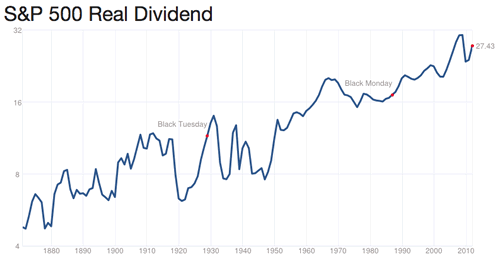I was following an interesting discussion about living off of dividend income from stocks over at the Bogleheads forum, and member Beagler posted a link to a excerpt on income investing from the book Bogle on Mutual Funds.
You may know that John Bogle is the founder of Vanguard, now one of the largest fund organizations in the world and a pioneer in low-cost index funds. But what I really like about his books is his focus on common sense as the foundation for his advice. An example of this is his Gotrocks parable [pdf] adapted from Buffett. But back to this excerpt. He first points out how stock dividends have been a good way to create an income stream over the long run that grows faster than inflation.
Of course, by investing in common stocks you assume the risk that dividends will decline during periods of recession or depression […] What is truly remarkable is that the record of dividend payments by U.S. corporations heavily favors rising dividends over declining dividends, almost irrespective of prevailing business conditions.
Here’s a chart of the historical S&P 500 annual dividend, inflation-adjusted. (Note this is absolute dividend, not dividend yield percentage.)
Now, the problem is that you can also pay too much for dividends. He shares an example of how if you were comparing the dividend income from a diversified stock portfolio yielding 3% and growing at 6% annually or a long-term bond yielding 7% each year, it would take 26 years for the dividend income to total the bond income payments.
Unfortunately, defining what constitutes too high a price for dividends is a fallible exercise, one that must take into account not only the average historical valuations for stocks but the current valuations for other investment alternatives as well. History suggests that stocks are relatively expensive when the price paid for $1 of dividends is above $30 (i.e., a yield of 3.3%) and relatively cheap when the price paid is less than $20 (a yield of 5%). However, stocks may well be attractive at a yield of, say, 3.5% if there are compelling reasons to assume that their dividends will increase rapidly or if yields on other classes of financial assets are relatively unattractive.
In the example shown in Figure 2-5, buying a portfolio of stocks at a 3% yield rather than a bond at a 7% yield might not be a sensible investment, especially considering the incremental risk incurred in holding stocks. When stocks yield 4.5% and bonds yield 6%, that may be quite another story.
What would Bogle say right now, when the S&P 500 yield is ~2% and 30-year Treasury bonds are ~3%? The relative difference between the stock yield and the bond yield is less than 1%. I would argue that his last sentence would suggest stocks are actually preferred over other classes at this point.
Now, I’m not turning in a stock bull, and I still have about 70% stocks and 30% bonds in my portfolio, but this line of thinking makes me happier with my 70% in stocks. I’ve also been looking more at living off of dividend income in “early retirement”.

 The Best Credit Card Bonus Offers – 2025
The Best Credit Card Bonus Offers – 2025 Big List of Free Stocks from Brokerage Apps
Big List of Free Stocks from Brokerage Apps Best Interest Rates on Cash - 2025
Best Interest Rates on Cash - 2025 Free Credit Scores x 3 + Free Credit Monitoring
Free Credit Scores x 3 + Free Credit Monitoring Best No Fee 0% APR Balance Transfer Offers
Best No Fee 0% APR Balance Transfer Offers Little-Known Cellular Data Plans That Can Save Big Money
Little-Known Cellular Data Plans That Can Save Big Money How To Haggle Your Cable or Direct TV Bill
How To Haggle Your Cable or Direct TV Bill Big List of Free Consumer Data Reports (Credit, Rent, Work)
Big List of Free Consumer Data Reports (Credit, Rent, Work)
You’ll notice the gyrations in the dividend level are far less than the changes on the price level of the index, at least in the last 50 or 60 years. Before that, I wonder if the extreme fluctuations were in large part caused by very high payout ratios back then.
I’ve started to mainly just track the absolute level of my portfolio dividend stream in order to denote progress toward my retirement and other financial goals. It’s a lot less nerveracking than watching the index levels, and if I never really liquidate anything as planned, then it may be a more relevant proxy of value anyway.
SB – Maybe it is because I just started but watching the absolute dollars of dividends have thoroughly depressed me lol
It’s a tough market at the moment, but money is still there to be made on the right dividend investments.
I couldn’t agree more with Jonathan… Money is still there to be made and trending has been the biggest indicator for me; totally agree about depressing absolute dollars of dividends.
I am now paying a lot more attention to dividends in my portfolio of index funds. I have dollar-cost-averaged funds over the last 4 years and am quite happy to see dividend income rise due to additions (and compounding) of my funds. As per the chart, I hope the trend continues.